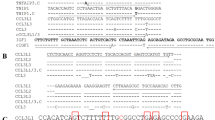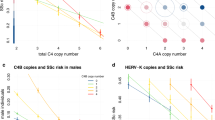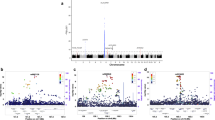Abstract
Naturally occurring variation in gene copy number is increasingly recognized as a heritable source of susceptibility to genetically complex diseases. Here we report strong association between FCGR3B copy number and risk of systemic lupus erythematosus (P = 2.7 × 10−8), microscopic polyangiitis (P = 2.9 × 10−4) and Wegener's granulomatosis in two independent cohorts from the UK (P = 3 × 10−3) and France (P = 1.1 × 10−4). We did not observe this association in the organ-specific Graves' disease or Addison's disease. Our findings suggest that low FCGR3B copy number, and in particular complete FCGR3B deficiency, has a key role in the development of systemic autoimmunity.
This is a preview of subscription content, access via your institution
Access options
Subscribe to this journal
Receive 12 print issues and online access
$209.00 per year
only $17.42 per issue
Buy this article
- Purchase on Springer Link
- Instant access to full article PDF
Prices may be subject to local taxes which are calculated during checkout

Similar content being viewed by others
References
Sebat, J. et al. Science 305, 525–528 (2004).
Iafrate, A.J. et al. Nat. Genet. 36, 949–951 (2004).
Tuzun, E. et al. Nat. Genet. 37, 727–732 (2005).
Redon, R. et al. Nature 444, 444–454 (2006).
Stankiewicz, P. et al. Trends Genet. 18, 74–82 (2002).
Lupski, J.R. Nat. Genet. 38, 974–976 (2006).
Aitman, T.J. et al. Nature 439, 851–855 (2006).
Salmon, J.E. et al. Arthritis Rheum. 44, 739–750 (2001).
Takai, T. J. Clin. Immunol. 25, 1–18 (2005).
Nimmerjahn, F. et al. Immunity 24, 19–28 (2006).
de Haas, M. et al. Blood 86, 2403–2413 (1995).
Clark, M.R. et al. J. Clin. Invest. 86, 341–346 (1990).
Coxon, A. et al. Immunity 14, 693–704 (2001).
Harper, L. et al. J. Pathol. 190, 349–359 (2000).
Gonzalez, E. et al. Science 307, 1434–1440 (2005).
Acknowledgements
We thank C. Neuwirth and Y. Tan (Clinical Sciences Centre); A. Wong (Imperial College); J. Cedric and M. Delpech (INSERM U567); M. Marre (INSERM U695) and B. Balkau (INSERM U780-IFR69) for their role in collecting patients and controls. We thank A. Tsalenko, A. Scheffer, N. Sampas, P. Tsang and L. Bruhn from Agilent Laboratories for contributions to the array comparative genomic hybridization results. We acknowledge intramural funding from the Clinical Sciences Centre (to T.J.A.) and support from the Wellcome Trust Cardiovascular Functional Genomics award (T.J.A.), from the FP6 EURATools (European Union contract number LSHG-CT-2005-019015) award (T.J.A.), from the UK MRC (T.J.A., H.T.C.) and from a Wellcome Trust Senior Fellowship (T.J.V.). We acknowledge use of genotype data from the British 1958 Birth Cohort DNA collection, funded by the UK Medical Research Council grant G0000934 and the Wellcome Trust grant 068545/Z/02.
Author information
Authors and Affiliations
Contributions
M.F., E.P., H.T.C., T.J.V. and T.J.A. designed the study. M.F., P.J.N. and R.D. performed PCR-based experiments. A.d.S., A.I.F.B. and P.F. performed oligonucleotide array comparative genomic hybridization analysis. M.F. and E.P. performed statistical and data analysis. L.H., L.K., J.M.H., S.C.L.G., P.F., C.J.O., S.H.S.P., L.T., L.G., D.S.G.G., C.D.P. and T.J.V. provided material and contributed to the collection of the case-control studies. The manuscript was written by M.F., E.P., H.T.C., T.J.V. and T.J.A.
Corresponding author
Ethics declarations
Competing interests
The authors declare no competing financial interests.
Supplementary information
Supplementary Fig. 1
Semiquantitative PCR. (PDF 220 kb)
Supplementary Fig. 2
Comparison between quantitative PCR and oligonucleotide array comparative genomic hybridization assays for copy number quantification at FCGR3B. (PDF 83 kb)
Supplementary Table 1
Descriptive characteristics of case-control cohorts. (PDF 90 kb)
Supplementary Table 2
Primer sequences. (PDF 51 kb)
Rights and permissions
About this article
Cite this article
Fanciulli, M., Norsworthy, P., Petretto, E. et al. FCGR3B copy number variation is associated with susceptibility to systemic, but not organ-specific, autoimmunity. Nat Genet 39, 721–723 (2007). https://doi.org/10.1038/ng2046
Received:
Accepted:
Published:
Issue Date:
DOI: https://doi.org/10.1038/ng2046
This article is cited by
-
Association between the AKT1 single nucleotide polymorphism (rs2498786, rs2494752 and rs5811155) and microscopic polyangiitis risk in a Chinese population
Molecular Genetics and Genomics (2023)
-
Genetics of ANCA-associated vasculitis: role in pathogenesis, classification and management
Nature Reviews Rheumatology (2022)
-
Systemic Sclerosis Association with Malignancy
Clinical Reviews in Allergy & Immunology (2022)
-
Identification of differentially expressed circulating exosomal lncRNAs in IgA nephropathy patients
BMC Immunology (2020)
-
Concordance rate between copy number variants detected using either high- or medium-density single nucleotide polymorphism genotype panels and the potential of imputing copy number variants from flanking high density single nucleotide polymorphism haplotypes in cattle
BMC Genomics (2020)



